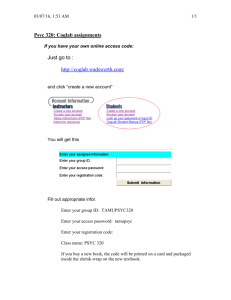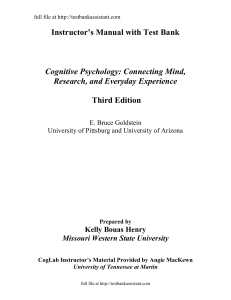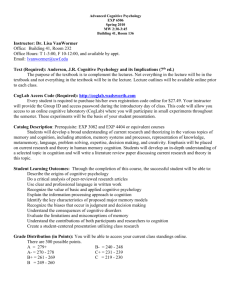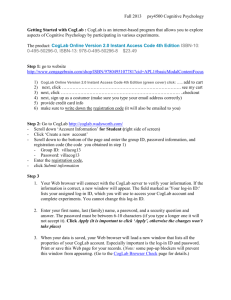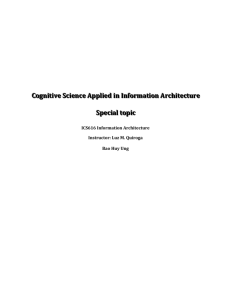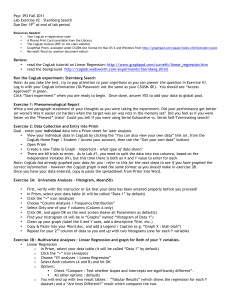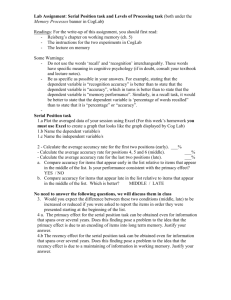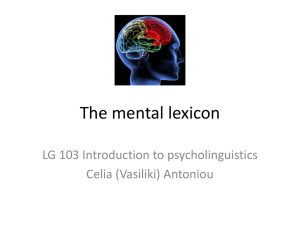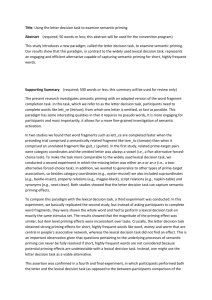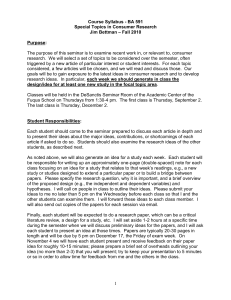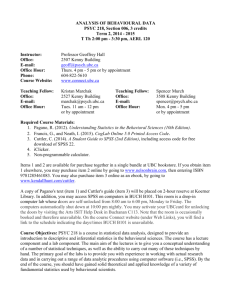Running head: LEXICAL DECISION
advertisement
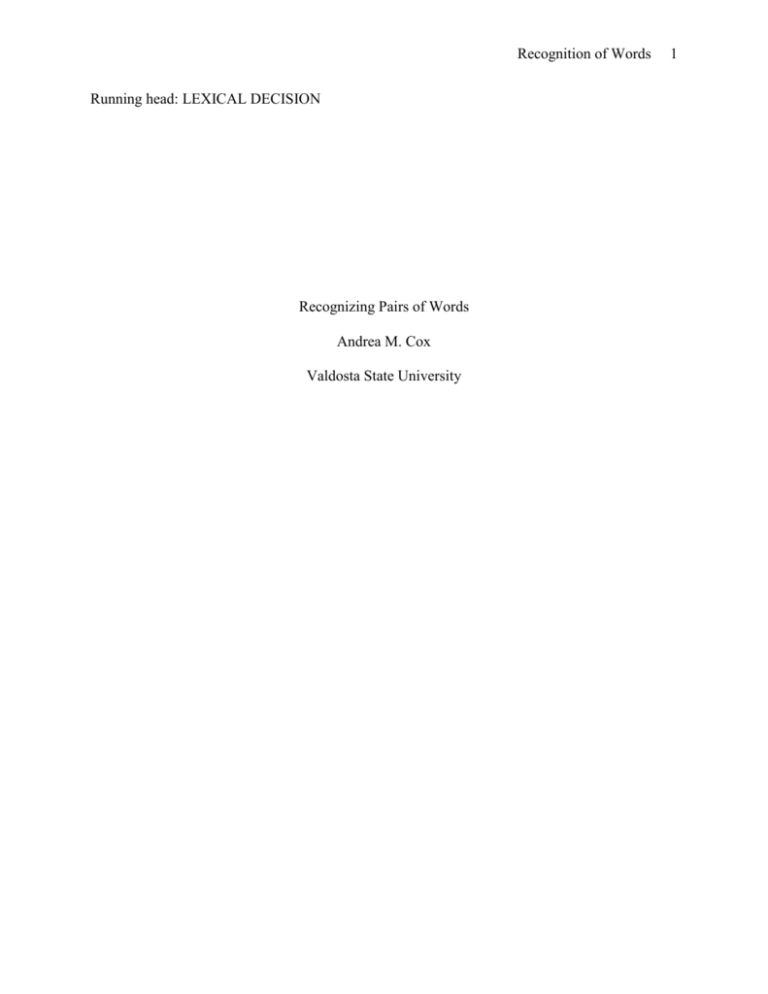
Recognition of Words Running head: LEXICAL DECISION Recognizing Pairs of Words Andrea M. Cox Valdosta State University 1 Recognition of Words Abstract This study examined the effect of related or unrelated pairs of words on response time. Participants’ were measured using the Lexical Decision experiment from the Coglab Website. Participants were given pairs of words and then timed on their reaction to choosing if the words were related or not related due to priming. As predicted, reaction time was faster when the two words were related than when they were not related. The results are discussed within the Spreading Activation Theory (Solso, 2001). 2 Recognition of Words 3 Recognizing Pairs of Words Language is built upon many rules and meanings that help us to communicate and interpret the world around us. When language is brought into the brain to be translated there is a mental dictionary that contains information about words. This dictionary is also known as a lexicon which contains information about a word’s meaning, its part of language, and its relationship to other words (Francis, Mackewn, Neath, & Goldthwaite, 2003). Relationships of words are very important in the study of cognitive psychology. Studies have been done to test semantic relationships and to find that if words are related to each other then they should be close in the lexicon whereas, words that are not related to each other should be far apart. These studies are also known as lexical-decision tasks which are a type of priming task that measures participant responses to whether paired strings of letters were words (Solso,2001). Meyer and Schvaneveldt (1971) did studies that supported this information. They used pairs of words, pairs of nonwords, and pairs involving a word and a nonword for practice stimuli. The study gauged participants’ reaction time in responding if the paired words were words or nonwords. Results showed that response times were faster for those pairs that were primed to be associated than for pairs that were unassociated. This experiment illustrates how search time for a word is shorter if the paired word is associated to the previous word. The purpose of this study was to examine further the relationship between word associations and reaction time. Participants were given 70 trials of word groups in which they were to respond if the pairings were associated or not associated. In this study, it is predicted that Recognition of Words 4 participants would respond quicker if the paired words were primed to be associated than if the paired words were not associated. Method Participants There were a total of 22 participants for each condition in the experiment that participated for an upper level psychology course. Participants were required to do the study for a grade and no extra credit was given for the study. All participants were treated in accordance with the ethical guidelines of the American Psychological Association (American Psychological Association, 1992). Materials Participants were instructed to run their experiment using a computer with web access. The computer must have had a Java program on it for the experiment to run correctly. The experiment was performed using the Coglab Website, www.coglab.wadsworth.com or was conducted using the Coglab CD Rom. Procedure Participants were told that the experiment was to decide that if words were arranged in the lexicon by semantic relationships, then words that are related to each other would be close in the lexicon whereas, words that are unrelated would be far apart. Instructions to participants. Participants were first told to press the space bar to start the trial and then stare at the square in the middle of the screen. Two to three seconds later, participants were told that a word or nonword would appear on the screen above the fixation point. Participants were then told to decide as quickly as possible whether or not it was a word or nonword. Participants were told to press the l key if the item was a word and to press the z key if Recognition of Words 5 it was not a word. The fixation square would turn red when participants keyed their answer so that they would know their response had been recorded. After keying their answer, participants were told two to three seconds later that a word or nonword would appear on the screen again. Participants were to decide if this was a word or not and key in their response as quickly as possible. Participants then received feedback on whether they chose correctly or not. Participants were then told to press the space bar to start the next trial. There were at least 70 trials total. Classification of the items must have been made correctly so participants were instructed to slow down if they were making many errors. Participants were allowed breaks if needed after they keyed in their responses but before they pressed the space bar to continue. By pressing the t key, participants were allowed to discard a trial that would be repeated later. Results The effect of pairs of items on response time was analyzed using a with-in subject analysis of variance (ANOVA). The ANOVA showed the effect of priming (sphericity assumed) to be significant, F(1, 21) = 7.02, p < .05. As seen in Table 1, participants showed that the words that were associated due to priming had faster response times (573 ms.) than words that were not associated (613 ms.). Discussion The results from the present study supported the prediction that participants will have a faster response time with words that are associated compared to words that are not associated. In other words, if the second word was related to the first word, than the participant should have responded faster to the second word than if the second word was not related to the first word. This experiment demonstrates the effect of priming. Priming is a result of being able to respond to words more quickly when they are associated than when they are not. Priming is Recognition of Words demonstrated when a stimulus is presented and then is followed by a short delay. A second stimulus then comes on and then the participant is asked to make some decision on the second stimulus (Solso, 2001). As Solso (2001) stated, “The rationale behind priming experiments, especially those designed to test semantic effects, is that by activating one item which may be related to another item, the acceptability of the second item is enhanced.” In other words, when the first word is activated, it activates a word nearby and makes the second word easier to identify. This is the basis for the spreading activation theory developed by Allan Collins and Elizabeth Loftus. The spreading activation theory follows the model of having specific memories being scattered in space with concepts that are related and then are linked by associations (Solso, 2001). Interpreting language and other sensory information is an important part of the brain. How the brain goes about taking language and memories and recalling it to other things is hard to demonstrate. With experiments like the Lexical Decision Task, we are able to see how priming is used to do these jobs. With this knowledge maybe we can start to put this technique towards other studies, such as studying for tests, so information can be recalled easier. 6 Recognition of Words References American Psychology Association. (1992). Ethical principles of psychologists and code of Conduct. American Psychologist, 47, 1597-1611. Francis, G., Mackewn, A., Neath, I., & Goldthwaite, D. (2003). Coglab student manual for 36 Experiments. Retrieved February 20, 2004, from Coglab Web site: www.coglab.wadsworth.com Meyer, D. E., & Schvaneveldt, R. W. (1971). Facilitation in recognizing pairs of words: Evidence of a dependence between retrieval operations. Journal of Experimental Psychology, 90(2), 227-234. Solso, R. L. (2001). Cognitive Psychology (6th ed.). Boston: Allyn and Bacon. 7 Recognition of Words Table 1 Participants’ Means and Standard Deviations of Associated and Not Associated Words Means Standard Deviations Associated Words 572.59 89.47 Non-Associated Words 612.68 99.75 8
